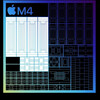Apple M4 (8 cores) vs Apple M4 Max (16 cores)
Apple M4 (8 cores)
► remove from comparison
The 8-core Apple M4 is an ARM architecture processor (SoC) that sports 8 CPU cores along with an 8-core GPU with hardware RT support and other modern features. A 16-core neural engine, USB 4 and Thunderbolt 4 are onboard, too.
The processor debuted in October 2024; it cuts down on the number of efficient cores but thankfully has the same 4 performance cores that its more powerful M4 brothers (non-Pro, non-Max) have. The P-cores probably run at 4.1 GHz or more; we don't have exact figures as of yet. The E-cores probably run at sub-3 GHz clock speeds.
This is the third member of the M4 (non-Pro, non-Max) family. It joins the 10-core M4 and the 9-core M4 that were unveiled several months before it.
The chip is believed to be based on the ARM v9.4-A microarchitecture to a certain extent. It comes with 16 GB or 24 GB of fast on-package LPDDR5x-7500 RAM; M3 processors had to be content with 6400 MT/s, for reference, while higher end M4 Pro and M4 Max processors get LPDDR5x-8533. It is not yet clear if this new chip is a 10-core M4 with several modules disabled, or if it's actually a new die that has fewer CPU and GPU cores by design.
Its performance is set to be very close to what Intel Lunar Lake processors such as the 256V deliver.
As far as power consumption is concerned, the SoC probably eats about 10 W when under long-term workloads. We'll update this section once we have one of the new Macs in for testing.
Apple M4 Max (16 cores)
► remove from comparisonThe 16-core Apple M4 Max is a powerful ARM architecture processor (SoC) for laptops and mini-PCs that debuted in Sep 2024. It features 12 performance CPU cores running at well over 4 GHz along with 4 efficient cores running at under 3 GHz. The 40-core M4 Max GPU and at least 48 GB of fast 546 GB/s LPDDR5x on-package memory depending on the configuration are included as well, as is USB 4 and Thunderbolt 5 support.
The built-in 16 core neural engine (up to 38 TOPS) is found across the whole M4 chip family. Furthermore, all M4 processors are thought to be based on the ARM v9.4-A architecture to a certain degree.
Performance
The M4 Max is set to be just around 15% faster than the 16-core M3 Max. This is very, very impressive.
Graphics
The 40-core M4 Max GPU has hardware support for ray tracing as well as mesh shading and other modern technologies. It supports external displays with resolutions as high as "8K" and it can HW-decode a few popular video codecs such as h.264, h.265 and AV1.
Its gaming performance is set to be about as good the GeForce RTX 4070 Laptop. Please keep in mind that very few games have been compiled specifically for Apple silicon Macs meaning most titles have to be run via emulation layers. Some of them are displayed with visual artefacts as a result, or don't start at all.
Power consumption
To let so many CPU and GPU cores breathe, some really high TDP figures are required. We assume the chip consumes 90 W to 100 W when under full load.
The 2nd generation 3 nm TSMC process the M4 Max is built with delivers good power efficiency, as of late 2024.
| Model | Apple M4 (8 cores) | Apple M4 Max (16 cores) | ||||||||||||||||||||||||||||||||||||||||||||||||||||||||
| Series | Apple M4 | Apple M4 | ||||||||||||||||||||||||||||||||||||||||||||||||||||||||
| Series: M4 |
|
| ||||||||||||||||||||||||||||||||||||||||||||||||||||||||
| Clock | 2900 - 4000 MHz | 2592 - 4512 MHz | ||||||||||||||||||||||||||||||||||||||||||||||||||||||||
| L2 Cache | 4 MB | 4 MB | ||||||||||||||||||||||||||||||||||||||||||||||||||||||||
| Cores / Threads | 8 / 8 4 x 4.4 GHz Apple M4 P-Core 2.9 GHz Apple M4 E-Core | 16 / 16 12 x 4.5 GHz Apple M4 P-Core 4 x 2.6 GHz Apple M4 E-Core | ||||||||||||||||||||||||||||||||||||||||||||||||||||||||
| TDP | 5 Watt | 90 Watt | ||||||||||||||||||||||||||||||||||||||||||||||||||||||||
| TDP Turbo PL2 | 15 Watt | |||||||||||||||||||||||||||||||||||||||||||||||||||||||||
| Technology | 3 nm | 3 nm | ||||||||||||||||||||||||||||||||||||||||||||||||||||||||
| Features | Unified Memory LPDDR5X-7500 (120 GB/s), 16-Core Neural Engine, Media Engine (Encoding / Decoding: H.264, HEVC, ProRes, ProRes RAW, AV1 Decoding only) | Unified Memory LPDDR5X-8533 (546 GB/s), 16-Core Neural Engine, Dual Media Engine (Encoding / Decoding: H.264, HEVC, ProRes, ProRes RAW, AV1 Decoding only) | ||||||||||||||||||||||||||||||||||||||||||||||||||||||||
| iGPU | Apple M4 8-core GPU | Apple M4 Max 40-Core GPU | ||||||||||||||||||||||||||||||||||||||||||||||||||||||||
| NPU / AI | 38 TOPS INT8 | 38 TOPS INT8 | ||||||||||||||||||||||||||||||||||||||||||||||||||||||||
| Architecture | ARM | ARM | ||||||||||||||||||||||||||||||||||||||||||||||||||||||||
| Announced |
Benchmarks
Average Benchmarks Apple M4 (8 cores) → 100% n=2
Average Benchmarks Apple M4 Max (16 cores) → 145% n=2
* Smaller numbers mean a higher performance
1 This benchmark is not used for the average calculation





